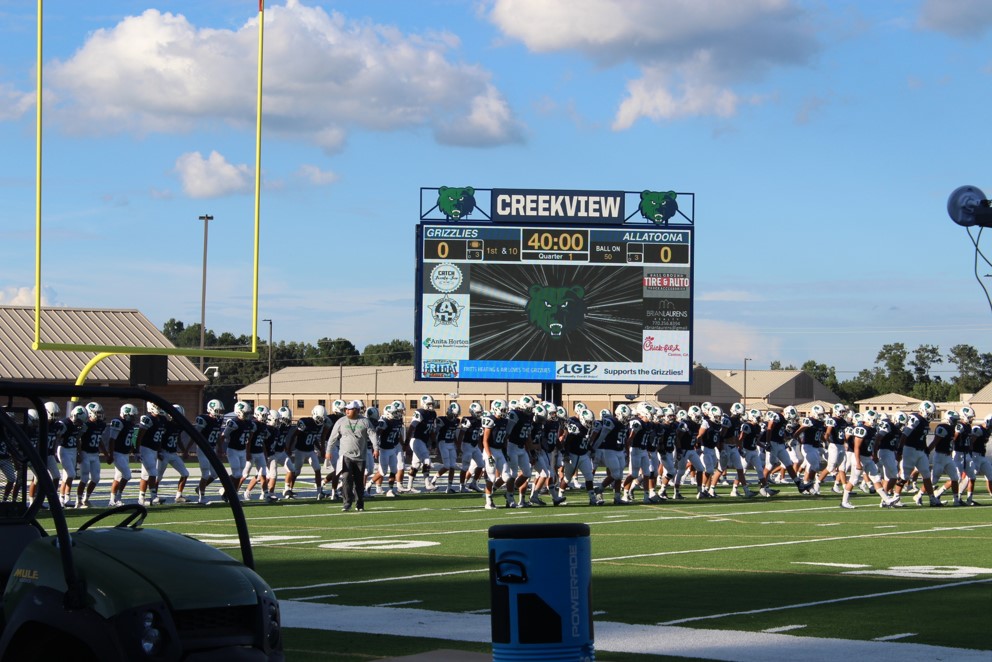Boosting the Bottom Line with Scoreboard Technology
Consumers have watched the cost of LED TVs plummet in the last half-decade. The technology is old hat and easy to manufacture — even for outdoor applications. Professional sports teams have used digital and video scoreboards for the better part of several decades. Good news: the technology is finally attainable for almost any sports program.
Creekview High School (Canton, Georgia) has made LED scoreboard technology a money-maker for the school. Over the summer, they installed two Multipurpose LED Video Scoreboards from Formetco — one indoor in the gymnasium and the other outdoors for the football field. They began to utilize the scoreboards in August 2018 and they span the gamut of basketball, wrestling and cheerleading indoors plus football, soccer, track and field, lacrosse and band outdoors. The indoor board was also recently used during an awards banquet.
The reactions have ranged from excitement to astonishment. “Players feel like a million bucks,” Michael Nayman, teacher at Creekview, said. Referees are enamored. Students, athletes, audience members — everyone in attendance — watches the content placed on the board, giving the gym and field the feel of a professional or college sports league.
The AV classes produce video content, interviews and green screen effects for the scoreboards. These students are able to work with technologies they will encounter later in life and build their own portfolios in the process.
Upgrading these scoreboards was not an overnight decision. Making the switch from a static digital board to an LED video scoreboard involved many moving pieces.
Dr. Mark Merges, principal at Creekview, and Michael Nayman, marketer and PR rep turned teacher and coach, lead the charge. They knew that adding advertising spots for static and video ads was a must for the success of these scoreboards. Nayman strongly believes other schools can duplicate Creekview’s success with these scoreboards and program surrounding them — as long as the schools are all-in on the technology.
What does he recommend?
1. Do some reflection on the school’s goals. What are sports programs trying to accomplish? Make the switch for the right reasons — to drive
revenue and better market the school to the community.
2. Have the right person in place. Whether this means a dedicated marketing guru, a teacher who is able to be used half-time or more for furthering marketing efforts of the school to the community, or a trained and motivated team of boosters, the effort has to be in place to get the program running. It may mean
creating the position from scratch.
3. Make a budget. Creekview has a sum each sport pays annually for the board; then any advertising the sport sells is theirs to keep for their program. All of the sports utilizing the board are making a tidy profit at Creekview.
Nayman spends time every day developing relationships with local businesspeople, and the results mean that the spots are in such high demand that Nayman believes he can increase the price tag on spots next year. In turn, the businesses are seen as supporting the school, get additional business (the announcers encourage spectators to visit the local pizza shop sponsor rather than Domino’s, for example) and have greater visibility in the community. “The biggest drawback at this point,” Nayman said, “is a lack of advertising spots. More people want to help the kids than I have spots available.”
In turn, the profits from the advertising available on the scoreboard mean that the capital investment will be paid off in three quarters of the amount of time budgeted and at the same time money is getting put back into arts, sports and other student development goals. Students are building portfolios and getting valuable experience working with the technology, too. The people who run the scoreboard and do all of the set-up are student volunteers, not professionals.
“The difference between this type of advertising and a banner attached to a fence or wall is that these digital ads are dynamic, lighted and much less expensive to produce than a large printed vinyl banner,” said Todd Heller, vice president of digital products at Formetco, who provided the new scoreboards at Creekview.
To learn more about how this technology can benefit your athletic programs and more, visit https://formetcosports.com.
© 2019 Formetco Sports







